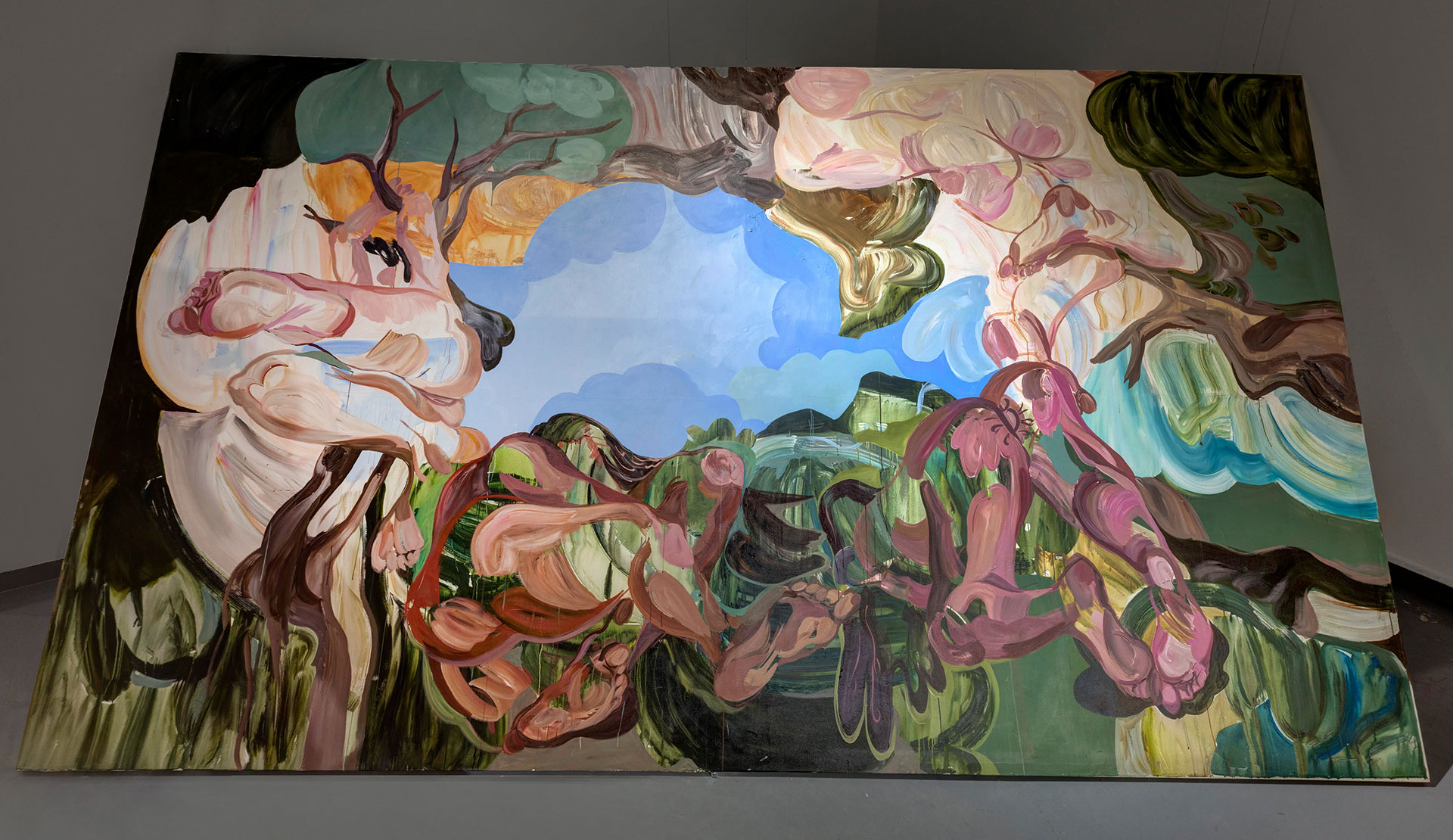PARADISO
Letter to access Mynerva and Abaddon’s underground paradise.
Dear Wynnie and Maria,
I am writing this letter to you both in an attempt to express the whirlwind of sensations that your artworks provoke in me in this underground paradise.
I wonder how to make my words have a dissolving effect, just as you make all bodily borders and categories burn through an explosion of textures and colors. Although I am addressing this letter to you, I feel that I am actually writing to the community of affection and complicity that accompanies and cares for you, that lives in your saliva, in your skin, in your fantasies, in your parties, in your breathing. I perceive in these works the sweat of many shared battles. For these images to exist, you have had to survive; you have traveled and expanded the paths that others before you opened where there were only impenetrable walls. You both are part of the same generation, school, and class origin in a racist and elitist society. You both have renounced the category of biological woman and belong to a community of sexual dissidence and trans & non- binary activism that shakes the earth. María and Wynnie do not conform to the phallocentric norm and the medical-scientific narrative of female identities: they have redesigned their sexual organs to enhance pleasure and introduced chemical, morphological, and hormonal variations into their bodies that challenge the architecture of modern anatomy.
In your paintings, Wynnie, bodies rehearse ritual choreographies, as if everyone came to celebrate with you the journey that allowed you to arrive at your anus as the sexual organ that best represents you. They are landscapes of excitement, full of winged torsos, double penetrations, stigmas, sewn vaginas, the stimulating and vasodilatory effects of substances such as LSD or poppers, reclining bodies, bristling tongues, and numerous anus expelling feces as if it were a public ceremony and a form of dialogue with the earth, where nails dug into the skin. The monumentality of your pieces makes me feel as if I am standing before a temple’s frescoes. Just as in the Renaissance, it was believed that there were souls waiting to be liberated within the marble, you, Wynnie, as a dissident transtemporal traveler, turn your canvases and pigments into an escape door for a grandiosity of beings that have abandoned their bodily limits and constraints. Just as in the Renaissance, it was believed that there were souls waiting to be liberated within the marble, you, Wynnie, as a dissident transtemporal traveler, turn your canvases and pigments into an escape door for a grandiosity of beings that have abandoned their bodily limits and constraints. Your paintings are also architecture: walls that open dark interstices in the white cube and invite us to imagine different encounters and movements. I am moved that they also commemorate your experience of surgery, transition, and escape from gender binaries, as it was a journey you took with company. Your paintings pay tribute to what sexual exploration, tenderness, and loving cooperation do in our lives.
Your sculptures, Maria, are glimpses of the future. Rarefied anatomies; exposed, stretched, pierced epidermises; pieces of flesh that flee from the bone structure;
vegetation and foliage that fantasize about a post-human ecology. These are also personal statements about what it means to modify your appearance in a world that punishes difference and deviation. Thus, your soft objects are a frenzy of delicacy and beauty that evoke the deep-sea and sidereal landscapes. The sculptural oasis that greets us in the middle of the space, surrounded by your unnamed creatures, seems to be a promise of Eden for those who live a nomadic existence. You use embroidery and crochet to weave wounds, mucus, scabs, bruises, as well as countless specimens of the fungal kingdom. The reproduction systems of fungi are the result of a sexual recombination and fusion with their environment; they possess qualities of both the plant and animal worlds without belonging to either. I see you camouflaged in that universe, escaping the policing processes of identification – of the nearly 4 million fungi, less than 150,000 have been registered by modern Western science -, claiming the trans experience beyond genital syntax and human morphology: a communication by electrical impulses, a network of stems and roots that plot an uprising beneath the ground.
The dialogue between the oil and the cotton from your artworks, have an hallucinogenic depth that momentarily makes me forget my own body. There is much that cannot be grasped through reason. This Paradiso is filled with paintings and hanging fabrics, dissected and sewn anatomies, cocoons that are cells that are mandalas, scars and traces of operations, threads that resemble melted skin, and bodily fluids as a form of spiritual communion. Freed from all laws and regulations, your characters proudly carry what many consider aberrant; They invite us to open our bodies and view the transformation of flesh as a possibility for another life.
Miguel A. López


Procesión, 1300 x 420 cm, oil on canvas.

Altar: La posibilidad de los deseos hecho carne, 1000 x 420 cm, oil on canvas.

Sacrificado sea mi nombre, 615 x 350 cm, oil on canvas.

Installation view in the Amil Project
Oil on canvas
Peru, 2022.